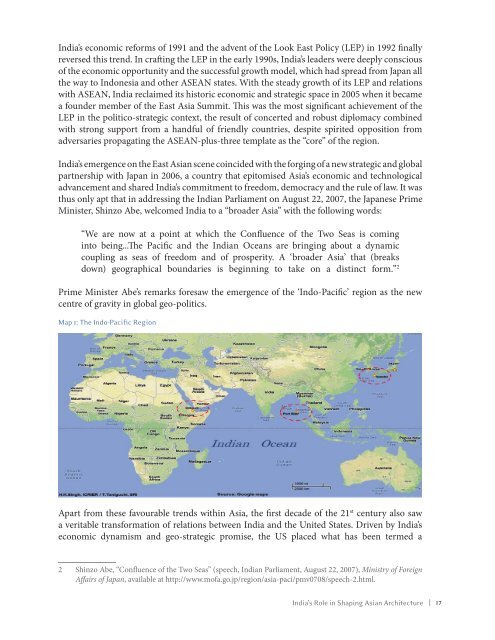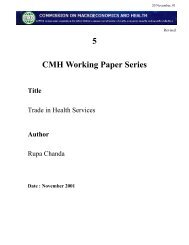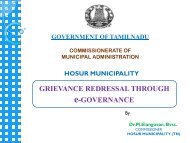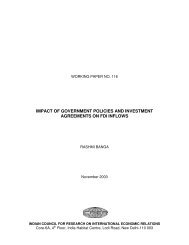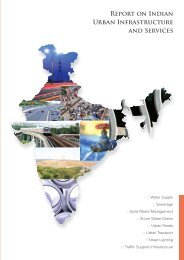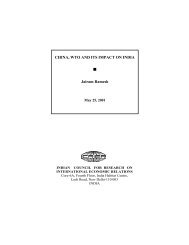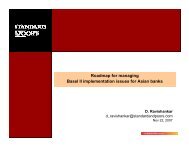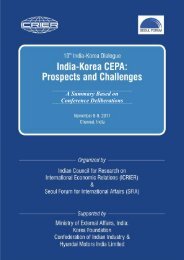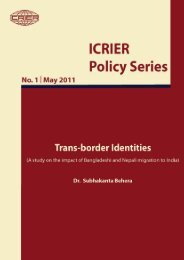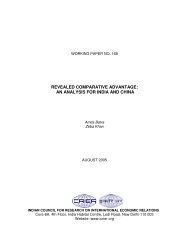Asia's Arc of Advantage - icrier
Asia's Arc of Advantage - icrier
Asia's Arc of Advantage - icrier
Create successful ePaper yourself
Turn your PDF publications into a flip-book with our unique Google optimized e-Paper software.
India’s economic reforms <strong>of</strong> 1991 and the advent <strong>of</strong> the Look East Policy (LEP) in 1992 finally<br />
reversed this trend. In crafting the LEP in the early 1990s, India’s leaders were deeply conscious<br />
<strong>of</strong> the economic opportunity and the successful growth model, which had spread from Japan all<br />
the way to Indonesia and other ASEAN states. With the steady growth <strong>of</strong> its LEP and relations<br />
with ASEAN, India reclaimed its historic economic and strategic space in 2005 when it became<br />
a founder member <strong>of</strong> the East Asia Summit. This was the most significant achievement <strong>of</strong> the<br />
LEP in the politico-strategic context, the result <strong>of</strong> concerted and robust diplomacy combined<br />
with strong support from a handful <strong>of</strong> friendly countries, despite spirited opposition from<br />
adversaries propagating the ASEAN-plus-three template as the “core” <strong>of</strong> the region.<br />
India’s emergence on the East Asian scene coincided with the forging <strong>of</strong> a new strategic and global<br />
partnership with Japan in 2006, a country that epitomised Asia’s economic and technological<br />
advancement and shared India’s commitment to freedom, democracy and the rule <strong>of</strong> law. It was<br />
thus only apt that in addressing the Indian Parliament on August 22, 2007, the Japanese Prime<br />
Minister, Shinzo Abe, welcomed India to a “broader Asia” with the following words:<br />
“We are now at a point at which the Confluence <strong>of</strong> the Two Seas is coming<br />
into being...The Pacific and the Indian Oceans are bringing about a dynamic<br />
coupling as seas <strong>of</strong> freedom and <strong>of</strong> prosperity. A ‘broader Asia’ that (breaks<br />
down) geographical boundaries is beginning to take on a distinct form.” 2<br />
Prime Minister Abe’s remarks foresaw the emergence <strong>of</strong> the ‘Indo-Pacific’ region as the new<br />
centre <strong>of</strong> gravity in global geo-politics.<br />
Map 1: The Indo-Pacific Region<br />
Apart from these favourable trends within Asia, the first decade <strong>of</strong> the 21 st century also saw<br />
a veritable transformation <strong>of</strong> relations between India and the United States. Driven by India’s<br />
economic dynamism and geo-strategic promise, the US placed what has been termed a<br />
2 Shinzo Abe, “Confluence <strong>of</strong> the Two Seas” (speech, Indian Parliament, August 22, 2007), Ministry <strong>of</strong> Foreign<br />
Affairs <strong>of</strong> Japan, available at http://www.m<strong>of</strong>a.go.jp/region/asia-paci/pmv0708/speech-2.html.<br />
India’s Role in Shaping Asian <strong>Arc</strong>hitecture | 17


